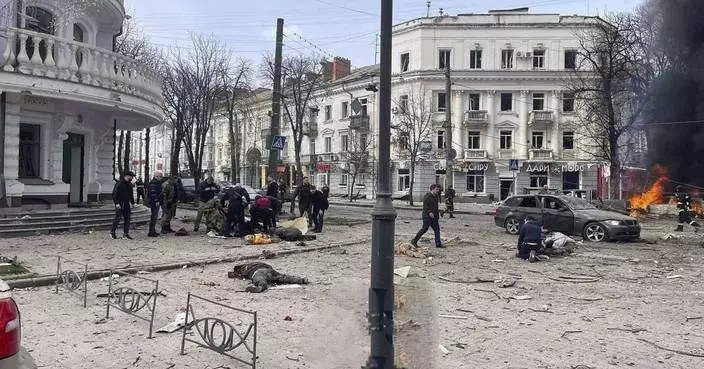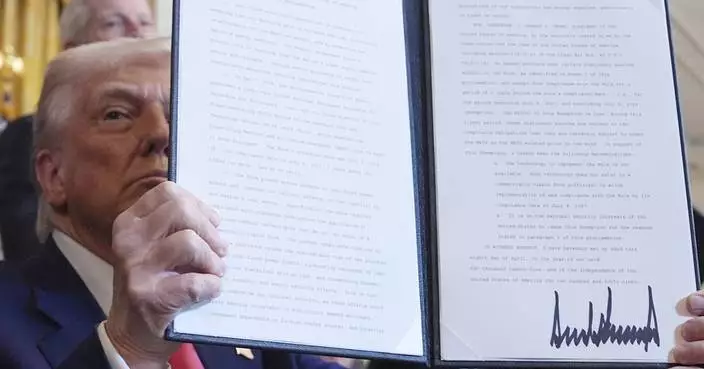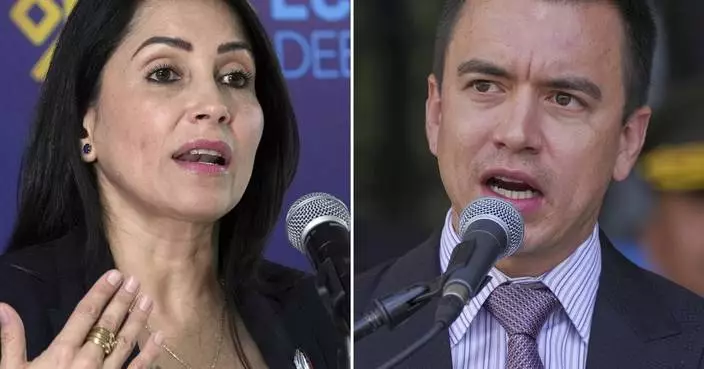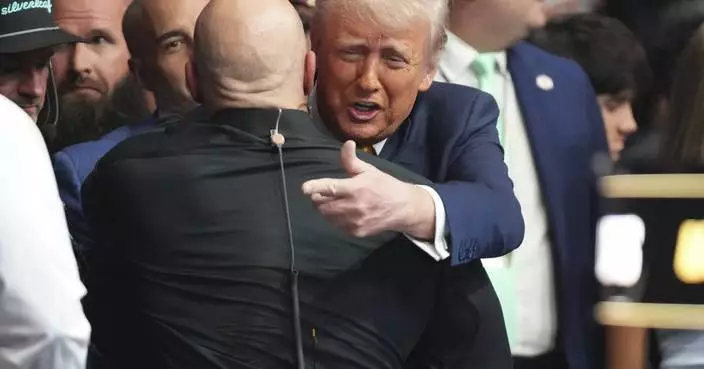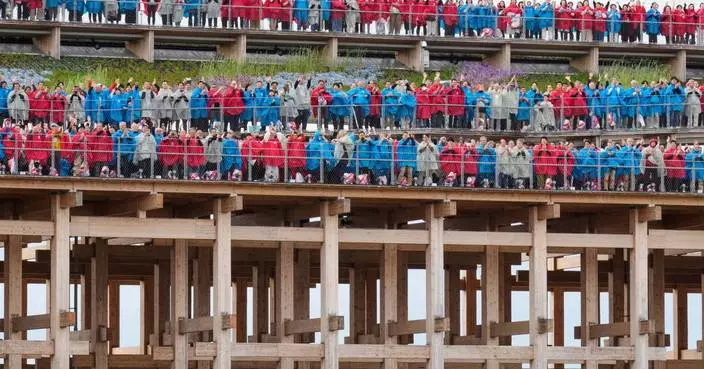The head of the Federal Aviation Administration told Congress during a hearing Thursday about a midair collision over Washington, D.C., that killed 67 people that the agency must do more to ensure flying remains safe.
The FAA's artificial intelligence-led review aimed at identifying safety threats at other airports with similar helicopter-airplane congestion should be finished in a couple weeks, said Chris Rocheleau, the agency’s acting administrator.
Click to Gallery
Sen. Tammy Duckworth, D-Ill., the ranking member of the Senate Transportation Subcommittee, speaks to Chris Rocheleau, acting administrator of the Federal Aviation Administration, during a hearing to examine the preliminary report by the National Transportation Safety Board on the Jan. 29, 2025, midair collision of an Army Black Hawk helicopter and an American Airlines regional jet, on Capitol Hill in Washington, Thursday, March 27, 2025. (AP Photo/J. Scott Applewhite)
Sen. Jerry Moran, R-Kan., chairman of the Senate Transportation Subcommittee, from left, Sen. Tammy Duckworth, D-Ill., the ranking member, and Sen. Maria Cantwell, D-Wash., begin a hearing to examine the preliminary report by the National Transportation Safety Board on the Jan. 29, 2025, midair collision of an Army Black Hawk helicopter and an American Airlines regional jet, on Capitol Hill in Washington, Thursday, March 27, 2025. (AP Photo/J. Scott Applewhite)
Sen. Tammy Duckworth, D-Ill., the ranking member of the Senate Transportation Subcommittee, joined at left by Chairman Jerry Moran, R-Kan., speaks to Chris Rocheleau, acting administrator of the Federal Aviation Administration, during a hearing to examine the preliminary report by the National Transportation Safety Board on the Jan. 29, 2025, midair collision by an Army Black Hawk helicopter and an American Airlines regional jet, on Capitol Hill in Washington, Thursday, March 27, 2025. (AP Photo/J. Scott Applewhite)
Brig. Gen. Matthew Braman, director of Army Aviation, center, answers questions, joined from left by Jennifer Homendy, chair of the National Transportation Safety Board, and Chris Rocheleau, acting administrator of the Federal Aviation Administration, as the Senate Transportation Subcommittee holds a hearing to examine the preliminary report by the National Transportation Safety Board on the Jan. 29, 2025, midair collision of an Army Black Hawk helicopter and an American Airlines regional jet, on Capitol Hill in Washington, Thursday, March 27, 2025. (AP Photo/J. Scott Applewhite)
Sen. Tammy Duckworth, D-Ill., the ranking member of the Senate Transportation Subcommittee, prepares for a hearing to examine the preliminary report by the National Transportation Safety Board on the Jan. 29, 2025, midair collision of an Army Black Hawk helicopter and an American Airlines regional jet, on Capitol Hill in Washington, Thursday, March 27, 2025. (AP Photo/J. Scott Applewhite)
Sen. Tammy Duckworth, D-Ill., the ranking member of the Senate Transportation Subcommittee, speaks to Chris Rocheleau, acting administrator of the Federal Aviation Administration, during a hearing to examine the preliminary report by the National Transportation Safety Board on the Jan. 29, 2025, midair collision of an Army Black Hawk helicopter and an American Airlines regional jet, on Capitol Hill in Washington, Thursday, March 27, 2025. (AP Photo/J. Scott Applewhite)
Sen. Jerry Moran, R-Kan., chairman of the Senate Transportation Subcommittee, from left, Sen. Tammy Duckworth, D-Ill., the ranking member, and Sen. Maria Cantwell, D-Wash., begin a hearing to examine the preliminary report by the National Transportation Safety Board on the Jan. 29, 2025, midair collision of an Army Black Hawk helicopter and an American Airlines regional jet, on Capitol Hill in Washington, Thursday, March 27, 2025. (AP Photo/J. Scott Applewhite)
FILE - A crane offloads a piece of wreckage from a salvage vessel onto a flatbed truck, near the wreckage site in the Potomac River of a mid-air collision between an American Airlines jet and a Black Hawk helicopter, at Ronald Reagan Washington National Airport, Feb. 5, 2025, in Arlington, Va. (AP Photo/Ben Curtis, File)
FILE - Rescue and salvage crews pull up a part of a Army Black Hawk helicopter that collided midair with an American Airlines jet, at a wreckage site in the Potomac River from Ronald Reagan Washington National Airport, Feb. 6, 2025, in Arlington, Va. (AP Photo/Jose Luis Magana, File)
FILE - A piece of wreckage is lifted from the water onto a salvage vessel near the site in the Potomac River of a mid-air collision between an American Airlines jet and a Black Hawk helicopter, at Ronald Reagan Washington National Airport, Feb. 4, 2025, in Arlington, Va. (AP Photo/Ben Curtis, File)
Jennifer Homendy, chair of the National Transportation Safety Board, stands next to map showing flight restrictions as the Senate Transportation Subcommittee holds a hearing to examine the preliminary report by the National Transportation Safety Board on the Jan. 29, 2024, midair collision of an Army Black Hawk helicopter and an American Airlines regional jet, on Capitol Hill in Washington, Thursday, March 27, 2025. (AP Photo/J. Scott Applewhite)
Sen. Tammy Duckworth, D-Ill., the ranking member of the Senate Transportation Subcommittee, joined at left by Chairman Jerry Moran, R-Kan., speaks to Chris Rocheleau, acting administrator of the Federal Aviation Administration, during a hearing to examine the preliminary report by the National Transportation Safety Board on the Jan. 29, 2025, midair collision by an Army Black Hawk helicopter and an American Airlines regional jet, on Capitol Hill in Washington, Thursday, March 27, 2025. (AP Photo/J. Scott Applewhite)
Brig. Gen. Matthew Braman, director of Army Aviation, center, answers questions, joined from left by Jennifer Homendy, chair of the National Transportation Safety Board, and Chris Rocheleau, acting administrator of the Federal Aviation Administration, as the Senate Transportation Subcommittee holds a hearing to examine the preliminary report by the National Transportation Safety Board on the Jan. 29, 2025, midair collision of an Army Black Hawk helicopter and an American Airlines regional jet, on Capitol Hill in Washington, Thursday, March 27, 2025. (AP Photo/J. Scott Applewhite)
Jennifer Homendy, chair of the National Transportation Safety Board, center, stands next to map showing flight restrictions as the Senate Transportation Subcommittee holds a hearing to examine the preliminary report by the National Transportation Safety Board on the Jan. 29, 2024, midair collision of an Army Black Hawk helicopter and an American Airlines regional jet, on Capitol Hill in Washington, Thursday, March 27, 2025. (AP Photo/J. Scott Applewhite)
During the hearing, the head of the National Transportation Safety Board and members of Congress again questioned how the FAA hadn’t noticed an alarming number of close calls near Ronald Reagan National Airport and addressed the problem before the January collision between an Army helicopter and a jetliner. The collision over the Potomac River was the nation's deadliest plane crash since November 2001.
“We have to do better,” Rocheleau said. “We have to identify trends, we have to get smarter about how we use data, and when we put corrective actions in place, we must execute them.”
The FAA is using AI to dig into the millions of reports it collects to assess other places with busy helicopter traffic including: Boston, New York, Baltimore-Washington, Detroit, Chicago, Dallas, Houston, Los Angeles and along the Gulf Coast. Rocheleau promised to take immediate action if risks are found.
Investigators have highlighted 85 close calls around Reagan airport in the three years before the crash that should have signaled a growing safety problem. Rocheleau told the aviation subcommittee of the Committee on Commerce, Science and Transportation that every close call is investigated and all the data was reviewed before, but this alarming trend was missed.
NTSB Chairwoman Jennifer Homendy said there clearly was an issue with identifying trends in the data the FAA collects.
Dailey Crofton, whose brother Casey Crofton died in the collision, attended the hearing.
“I was surprised at the lapses of safety protocols that led to this crash,” he said in a statement afterward.
Texas Sen. Ted Cruz said he learned that the Secret Service and U.S. Navy triggered a rash of collision alarms in planes around Reagan Airport on March 1 while testing anti-drone technology that used a similar frequency to the one used by planes' warning systems. Cruz said that happened despite a warning from the FAA against doing it.
“This is deeply disturbing that just a month after 67 people died while on approach to DCA (Reagan Airport), that the Secret Service and Pentagon would inadvertently cause multiple flights to receive urgent cockpit alerts recommending evasive action,” Cruz said.
Helicopter traffic around Reagan National has been restricted since January any time planes use the same runway the American Airlines plane that crashed was approaching when it collided with the helicopter. At the NTSB's urging, the FAA permanently banned that particular helicopter route under most circumstances. If a helicopter does use the route, planes are prohibited from taking off or landing on that runway.
The U.S. Army’s head of aviation Brig. Gen. Matthew Braman acknowledged that as of Thursday morning helicopters were still flying over the nation's capital with a key system broadcasting their locations turned off during most missions because it deemed them sensitive.
Cruz called this “shocking and deeply unacceptable.”
Rocheleau then said the FAA will immediately require all aircraft flying near Reagan National to broadcast their locations. The “ADS-B out data” is designed to help air traffic controllers better track an aircraft's location with position updates every second..
Before that announcement, exceptions in the airspace above Washington allowed Army and other government aircraft to fly without transmitting, or fly in a mode that allowed less information to be transmitted to avoid broadcasting potentially sensitive missions to the public.
Former Black Hawk pilot Tim Lilley, father of airliner copilot Sam Lilley, said he's disappointed that the Army has not taken simple steps to improve safety he recommended in a meeting with Braman, including turning on the locator systems, adding a fourth crew member or barring the use of older Black Hawks on routes around Washington.
“I was frustrated with the lack of accountability. The Army still doesn’t want to say that they did anything wrong,” said Lilley, who flew helicopter routes around the capital for four years in the 1990s as part of a 20-year Army career and now flies private jets.
Homendy also noted that it is important to inspect the transmission equipment to make sure it actually works. The helicopter involved in this collision had not transmitted any location data for 730 days. When the NTSB checked the rest of the unit's helicopters after the crash, it found eight of them that hadn’t transmitted since 2023.
Plus, Homendy said she's not sure what the Army was doing with any close call reports it received or how closely it was monitoring whether its helicopters violated altitude limits during their flights like the one that collided with the jetliner did. She said most of the safety conversations at the battalion level were focused on “OSHA slips, trips and falls.”
Associated Press writer Tara Copp contributed to this report from Washington D.C.
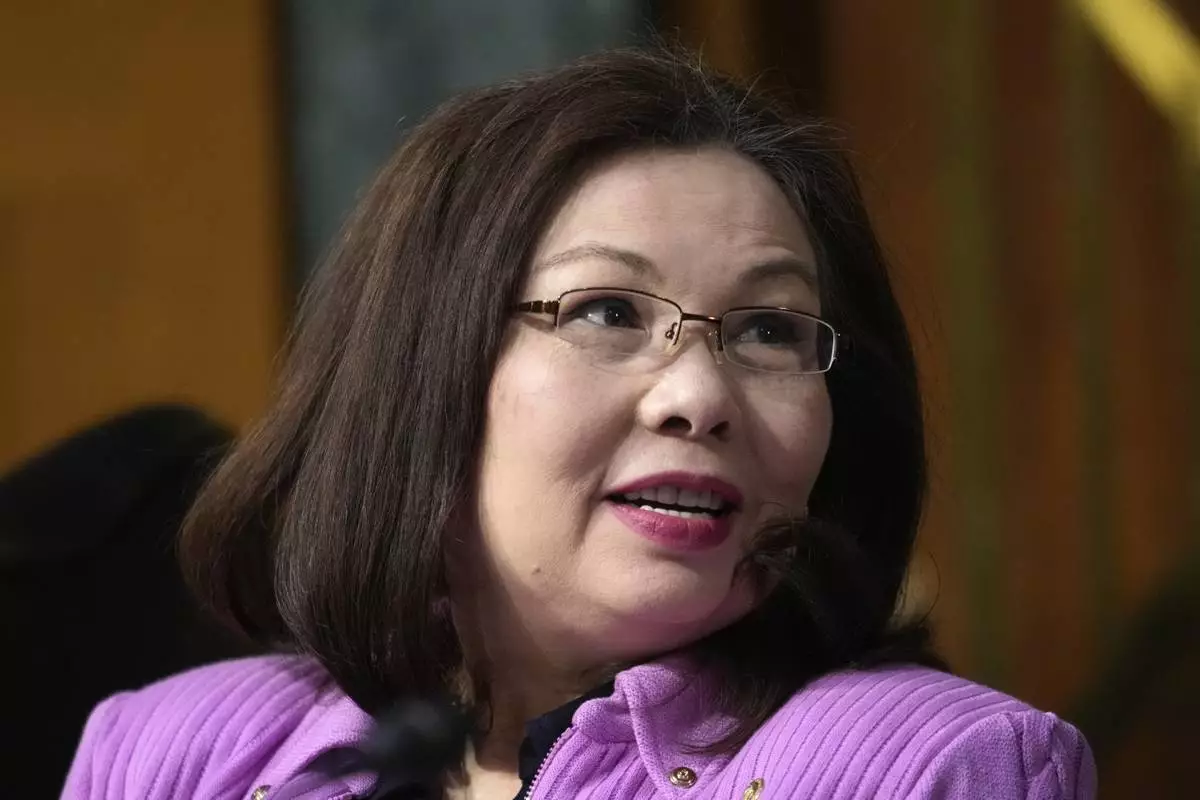
Sen. Tammy Duckworth, D-Ill., the ranking member of the Senate Transportation Subcommittee, prepares for a hearing to examine the preliminary report by the National Transportation Safety Board on the Jan. 29, 2025, midair collision of an Army Black Hawk helicopter and an American Airlines regional jet, on Capitol Hill in Washington, Thursday, March 27, 2025. (AP Photo/J. Scott Applewhite)
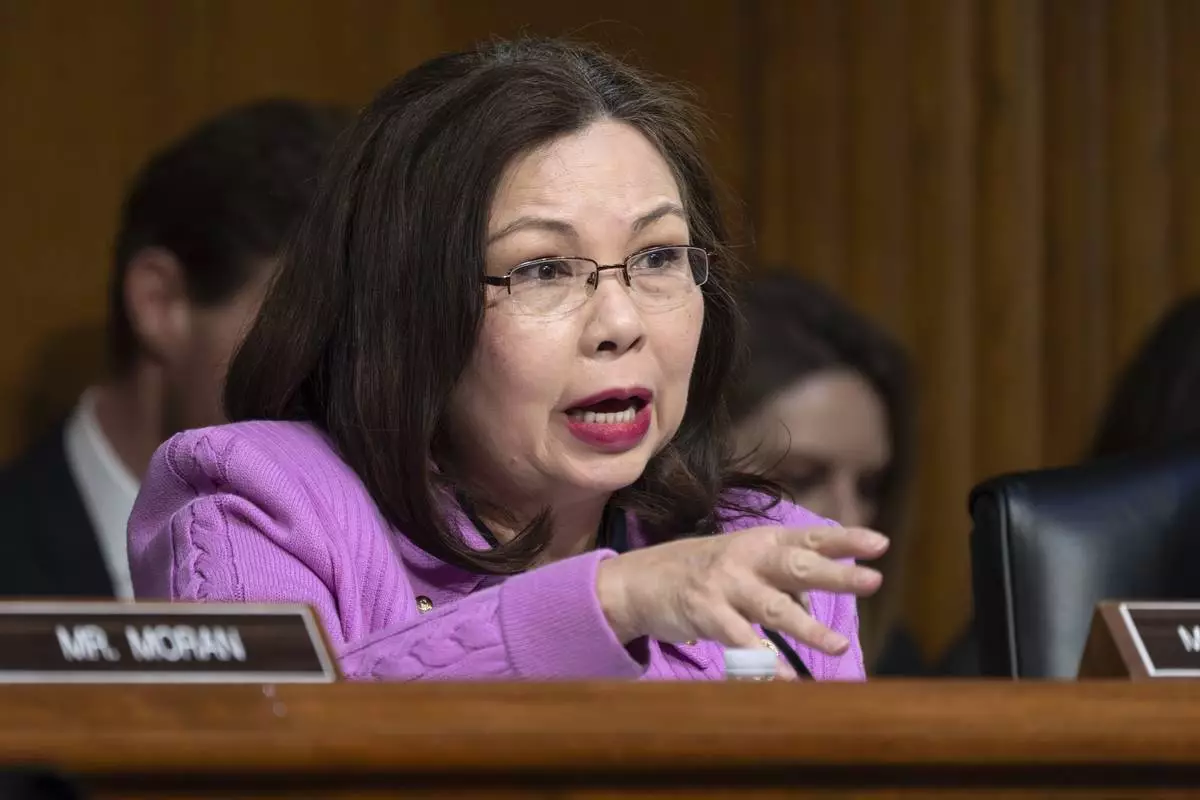
Sen. Tammy Duckworth, D-Ill., the ranking member of the Senate Transportation Subcommittee, speaks to Chris Rocheleau, acting administrator of the Federal Aviation Administration, during a hearing to examine the preliminary report by the National Transportation Safety Board on the Jan. 29, 2025, midair collision of an Army Black Hawk helicopter and an American Airlines regional jet, on Capitol Hill in Washington, Thursday, March 27, 2025. (AP Photo/J. Scott Applewhite)
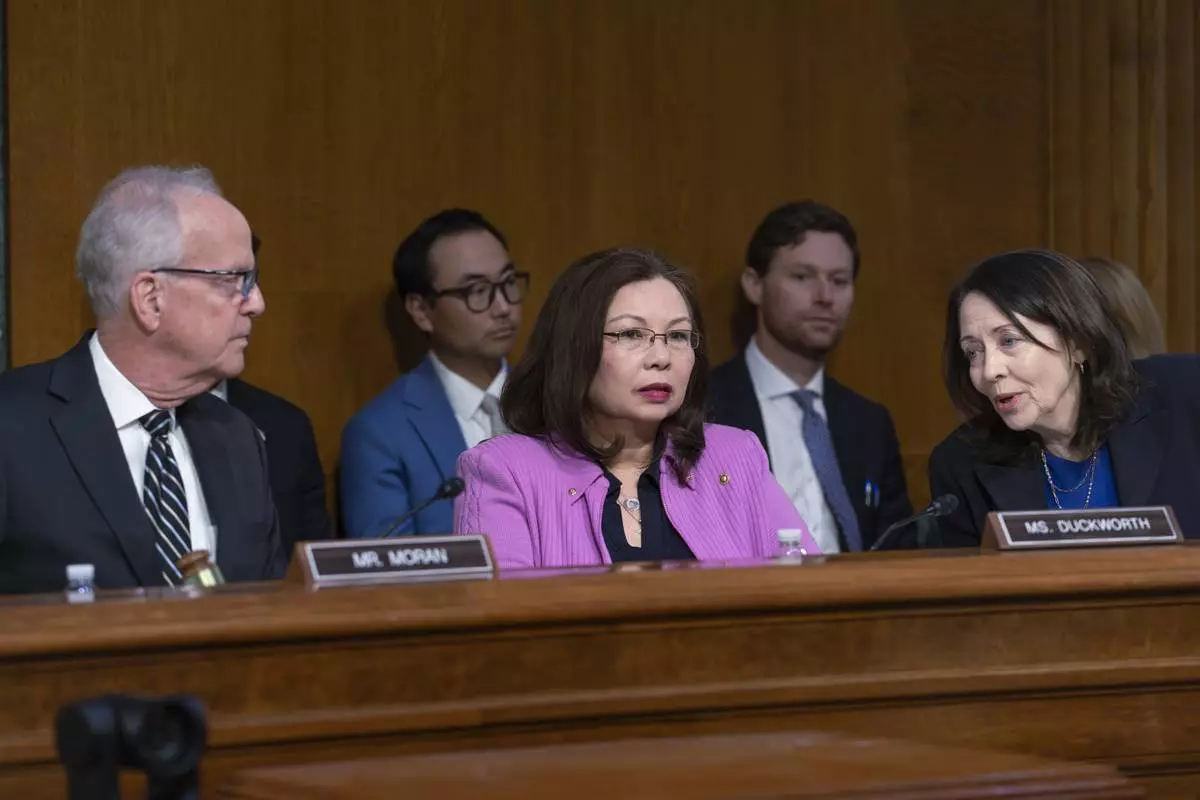
Sen. Jerry Moran, R-Kan., chairman of the Senate Transportation Subcommittee, from left, Sen. Tammy Duckworth, D-Ill., the ranking member, and Sen. Maria Cantwell, D-Wash., begin a hearing to examine the preliminary report by the National Transportation Safety Board on the Jan. 29, 2025, midair collision of an Army Black Hawk helicopter and an American Airlines regional jet, on Capitol Hill in Washington, Thursday, March 27, 2025. (AP Photo/J. Scott Applewhite)
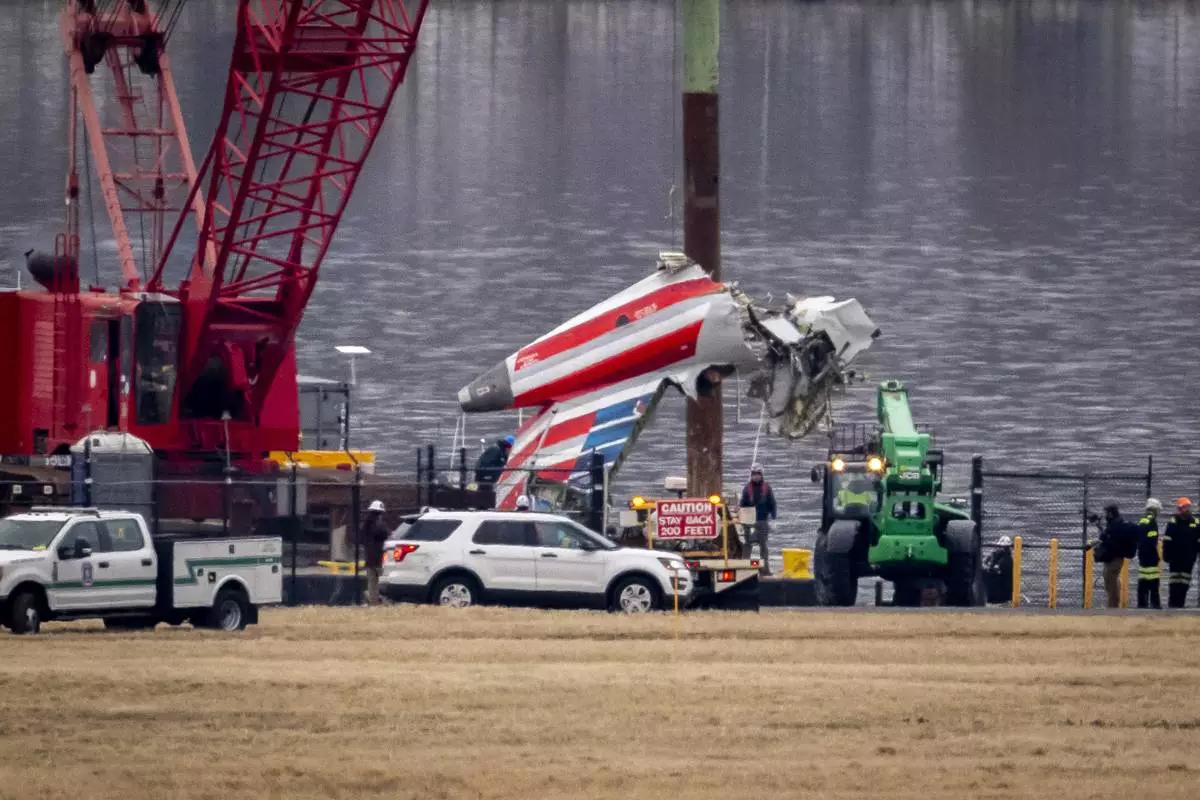
FILE - A crane offloads a piece of wreckage from a salvage vessel onto a flatbed truck, near the wreckage site in the Potomac River of a mid-air collision between an American Airlines jet and a Black Hawk helicopter, at Ronald Reagan Washington National Airport, Feb. 5, 2025, in Arlington, Va. (AP Photo/Ben Curtis, File)
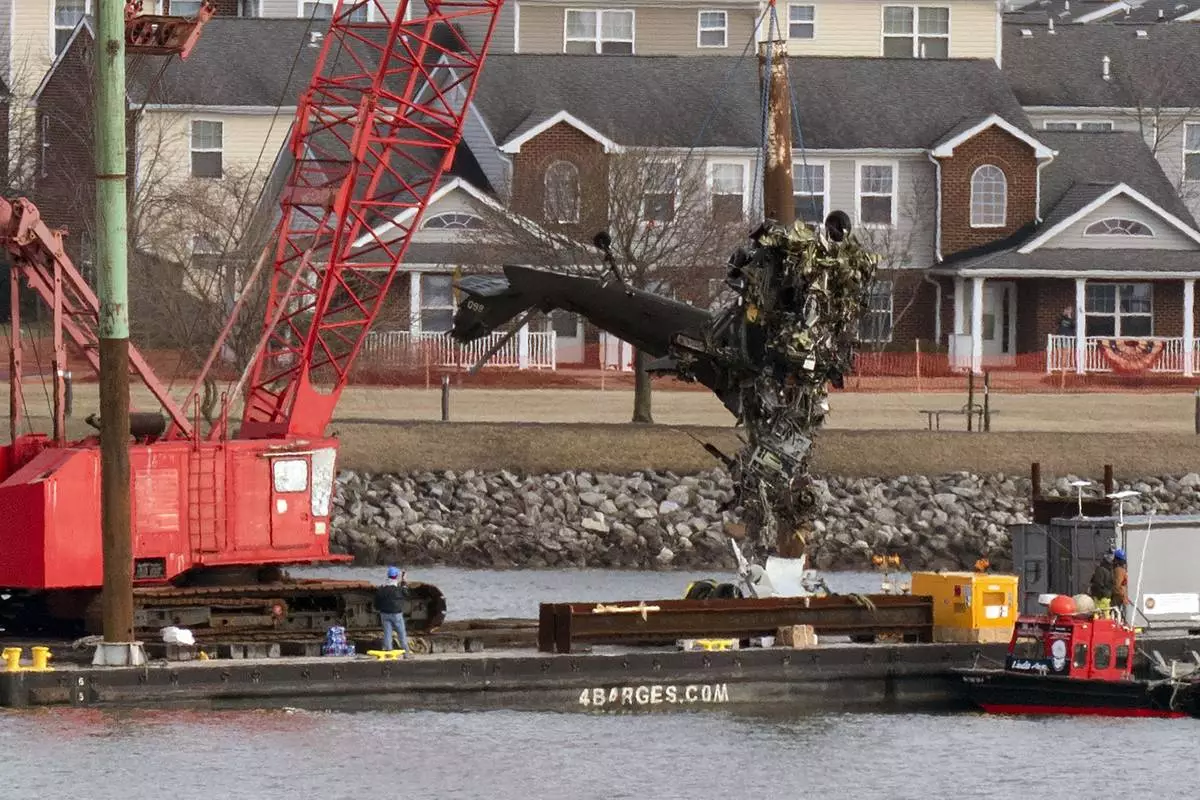
FILE - Rescue and salvage crews pull up a part of a Army Black Hawk helicopter that collided midair with an American Airlines jet, at a wreckage site in the Potomac River from Ronald Reagan Washington National Airport, Feb. 6, 2025, in Arlington, Va. (AP Photo/Jose Luis Magana, File)
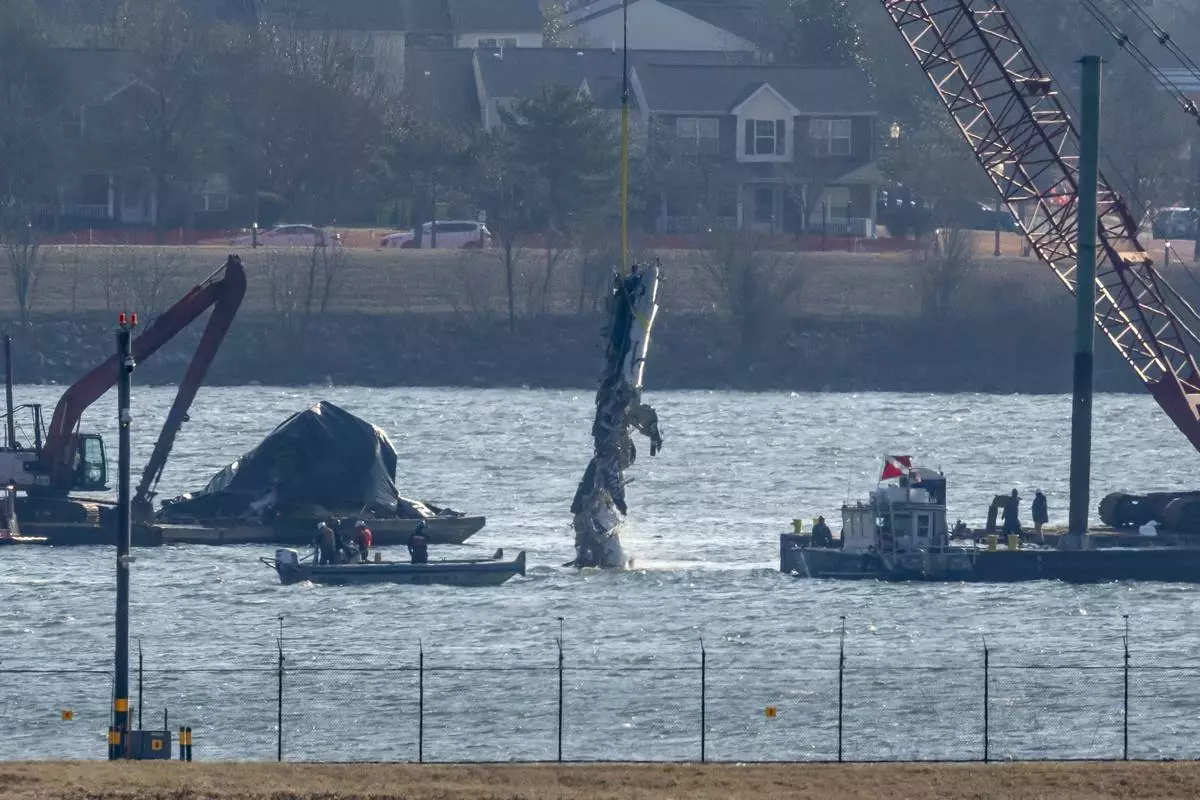
FILE - A piece of wreckage is lifted from the water onto a salvage vessel near the site in the Potomac River of a mid-air collision between an American Airlines jet and a Black Hawk helicopter, at Ronald Reagan Washington National Airport, Feb. 4, 2025, in Arlington, Va. (AP Photo/Ben Curtis, File)
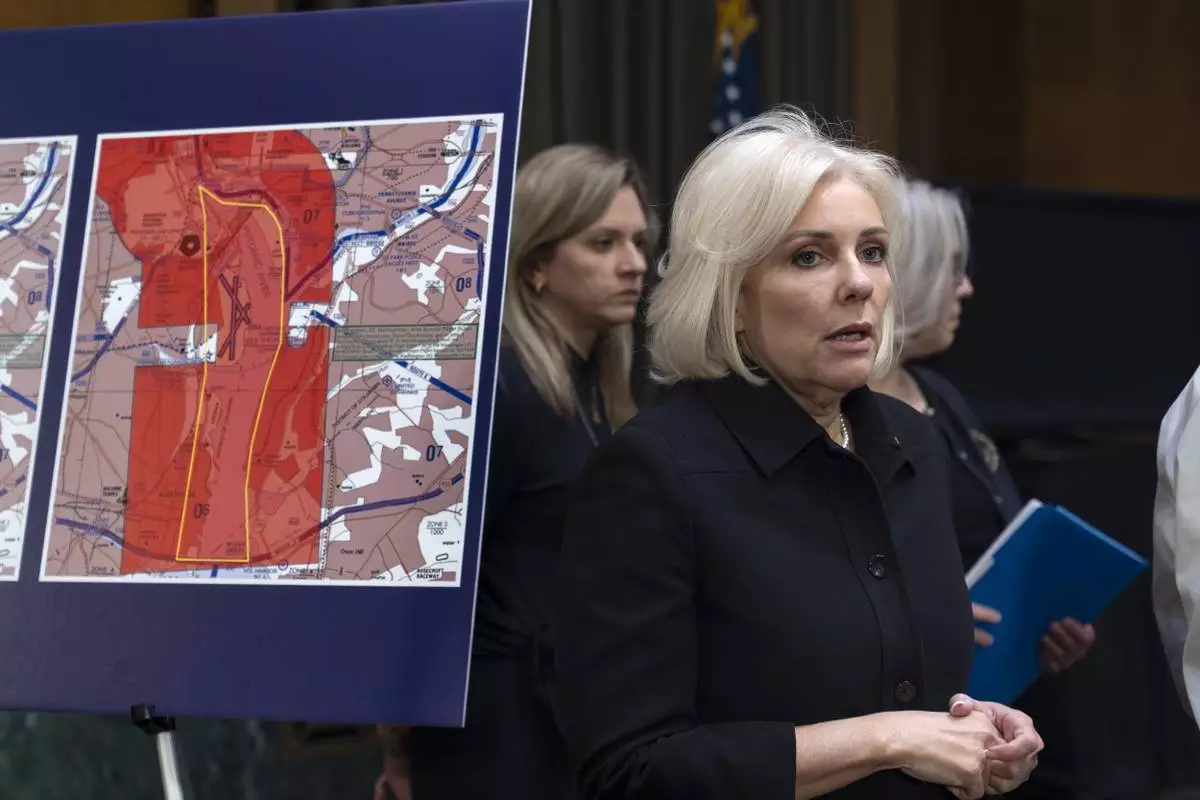
Jennifer Homendy, chair of the National Transportation Safety Board, stands next to map showing flight restrictions as the Senate Transportation Subcommittee holds a hearing to examine the preliminary report by the National Transportation Safety Board on the Jan. 29, 2024, midair collision of an Army Black Hawk helicopter and an American Airlines regional jet, on Capitol Hill in Washington, Thursday, March 27, 2025. (AP Photo/J. Scott Applewhite)
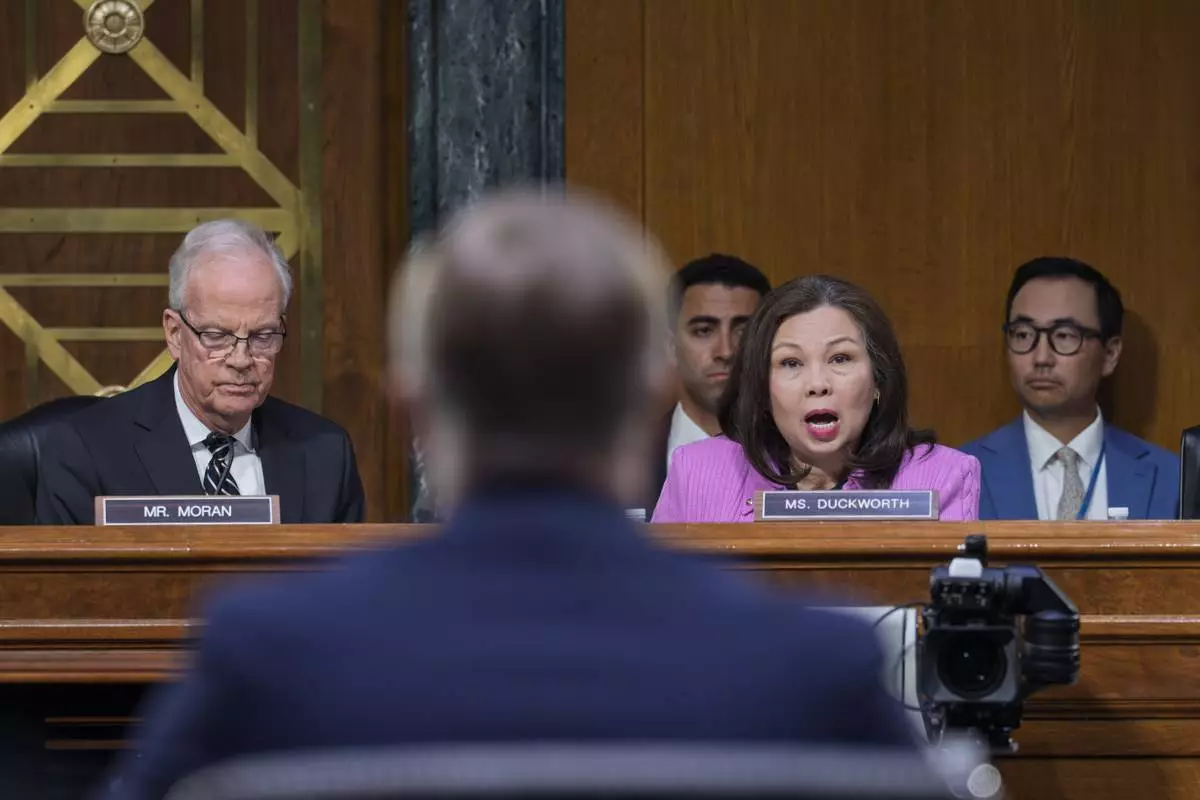
Sen. Tammy Duckworth, D-Ill., the ranking member of the Senate Transportation Subcommittee, joined at left by Chairman Jerry Moran, R-Kan., speaks to Chris Rocheleau, acting administrator of the Federal Aviation Administration, during a hearing to examine the preliminary report by the National Transportation Safety Board on the Jan. 29, 2025, midair collision by an Army Black Hawk helicopter and an American Airlines regional jet, on Capitol Hill in Washington, Thursday, March 27, 2025. (AP Photo/J. Scott Applewhite)

Brig. Gen. Matthew Braman, director of Army Aviation, center, answers questions, joined from left by Jennifer Homendy, chair of the National Transportation Safety Board, and Chris Rocheleau, acting administrator of the Federal Aviation Administration, as the Senate Transportation Subcommittee holds a hearing to examine the preliminary report by the National Transportation Safety Board on the Jan. 29, 2025, midair collision of an Army Black Hawk helicopter and an American Airlines regional jet, on Capitol Hill in Washington, Thursday, March 27, 2025. (AP Photo/J. Scott Applewhite)
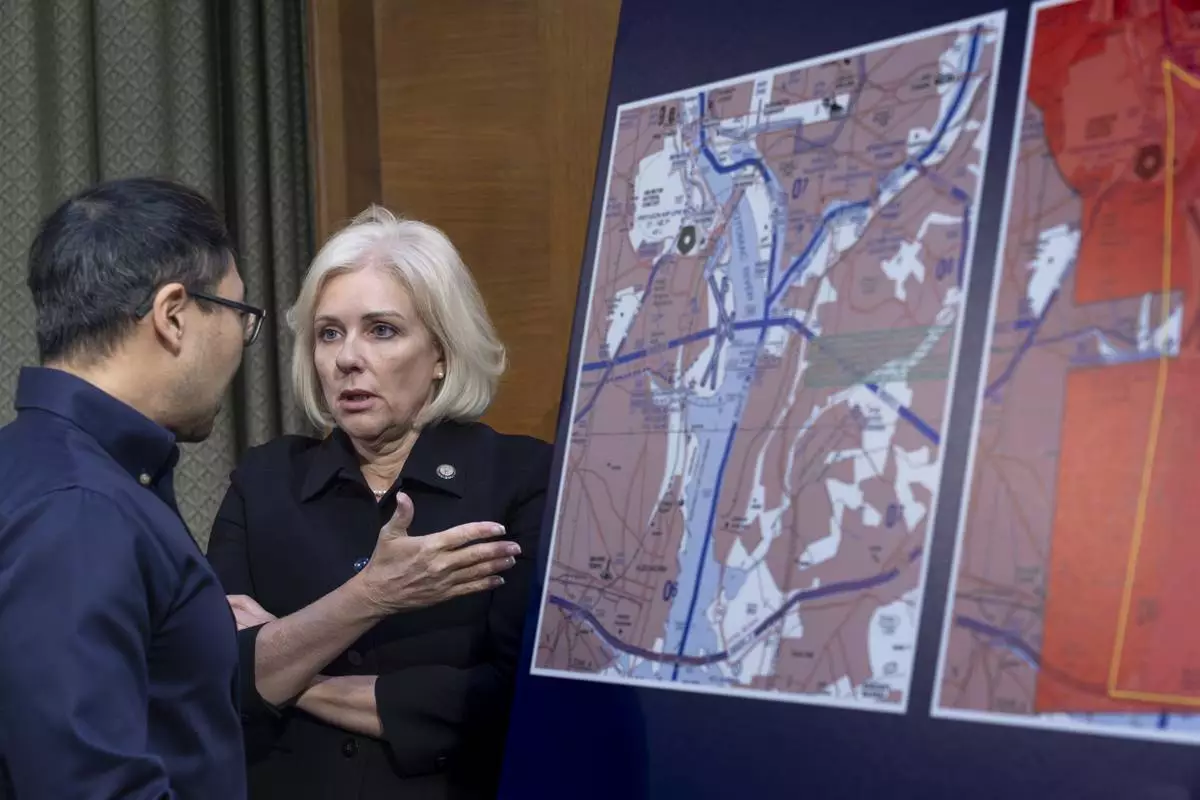
Jennifer Homendy, chair of the National Transportation Safety Board, center, stands next to map showing flight restrictions as the Senate Transportation Subcommittee holds a hearing to examine the preliminary report by the National Transportation Safety Board on the Jan. 29, 2024, midair collision of an Army Black Hawk helicopter and an American Airlines regional jet, on Capitol Hill in Washington, Thursday, March 27, 2025. (AP Photo/J. Scott Applewhite)
SAN JOSE, Calif. (AP) — Like many in the tech industry, Jeremy Lyons used to think of himself as a relatively apolitical guy.
The only time he had participated in a demonstration before now was in the opening days of Donald Trump’s first presidential term, when he joined fellow Google workers walking out of the company’s Silicon Valley campus to protest immigration restrictions. Google’s co-founder and its chief executive officer joined them.
Last weekend was Lyons' second, also against Trump, but it had a very different feel.
The man directing thousands of marchers with a bullhorn in downtown San Jose on April 5 was another tech worker who would not give his full name for fear of being identified by Trump backers. Marchers were urged not to harass drivers of Tesla vehicles, which have gone from a symbol of Silicon Valley’s environmental futurism to a pro-Trump icon. And no tech executives were anywhere to be seen, only months after several had joined Trump at his January inauguration.
To Lyons, 54, the change says as much about what’s happened to Silicon Valley over the past quarter-century as it does about the atmosphere of fear surrounding many Trump critics nowadays.
“One of the things I’ve seen over that time is a shift from a nerdy utopia to a money first, move fast and break things,” Lyons said.
The tech industry's political allegiances remain divided. But as some in the upper echelons of Silicon Valley began shifting to the right politically, many of the tech industry’s everyday workers have remained liberal — but also increasingly nervous and disillusioned. Their mood is in stark contrast to the prominent tech leaders who have embraced a conservative populist ideology.
“I think you're seeing a real gap between the leadership elite here in Silicon Valley and their workforce,” said Ann Skeet, who helps run a center at Santa Clara University studying the ethics of the tech industry.
“The shift hasn’t been for a lot of people,” said Lenny Siegel, a former mayor of Mountain View and longtime liberal activist in the valley. “It’s a handful of people who’ve gotten the attention.”
The biggest example of that is Elon Musk, the world’s richest person and CEO of the world’s best-known electric car company who has taken on a prominent role slashing federal agencies in Trump's administration. Musk has been joined by several tech billionaires, including investor David Sacks, who helped fundraise for Trump's campaign and became the White House’s artificial intelligence and cryptocurrency czar, and venture capitalist Marc Andreesen. Google CEO Sundar Pichai and Meta CEO Mark Zuckerberg also attended Trump's inauguration in Washington.
Zuckerberg began praising Trump after the then-candidate, angered over money Zuckerberg steered toward local election offices in some states in 2020 during the coronavirus pandemic, threatened last summer to imprison him. Zuckerberg also donated $1 million to the president's inauguration fund and co-hosted an inauguration reception for billionaire Republican donors.
Trump has filled a number of his administration's posts with billionaires and his support from wealthy tech leaders led Democratic President Joe Biden to warn that the United States risked becoming an oligarchy ruled by elites. During Trump's first term, the valley and its leaders were a bulwark of resistance to the Republican, especially over immigration, given that the industry draws its workforce from around the globe.
It's against that backdrop that thousands of people attended the recent rally at a downtown San Jose park to protest the actions of Trump and Musk.
Santa Clara County, which comprises most of Silicon Valley, swung 8 percentage points toward Trump in November election against Democrat Kamala Harris, matching the shift across California. Even with that swing, the county voted 68% to 28% for the then-vice president and remains a Democratic stronghold.
“We’re still in the belly of the beast,” said Dave Johnson, the new executive director of the Santa Clara GOP, who said the party has gained some new members in the county but few from the tech industry. “If the lake was frozen, there’s a little glimmer on top. I would not say there are cracks in the ice.”
The valley has long leaned Democratic, but with an unusual political mix: a general dislike of getting too involved in Washington’s business coupled with an at-times contradictory mix of libertarian individualism, Bay Area activism and belief in the ability of science to solve the world’s problems.
That has persisted even as the tech industry has changed.
The tech boom was fueled by scrappy startups that catered to their workers’ dreams of changing the world for the better. Google’s motto was “don’t be evil,” a phrase it removed from its code of conduct by 2018, when it and other companies such as Meta, which owns Facebook and Instagram, had grown into multinational behemoths. The companies have had layoffs in recent years, a shock to an industry that not long ago seemed poised for unlimited growth.
Entrepreneurs once dreamed of building startups that would change the world, said Jan English-Lueck, a San Jose State University professor who has been studying Silicon Valley culture for more than 20 years.
“Now,” she said, “if you’re part of a startup, you’re hoping you’ll be absorbed in a way that’s profitable.”
Even before some prominent tech leaders shifted toward Trump, there was mounting discontent among some in the industry over its direction. IdaRose Sylvester runs a business promoting a Silicon Valley-style approach to entrepreneurs in other countries.
“I feel sick to my stomach now,” she said.
Sylvester was already disenchanted with the growing inequality in the valley and the environmental cost of all the energy needed to power crypto, AI and data centers. She took part in protests against Trump in 2017, but felt that energy fade once he lost the 2020 election to Biden.
“I saw a lot of people get out of politics once Biden won. There was a feeling it was all OK,” Sylvester said. “It was not all OK.”
It is worse now, she said. She helped organize one of several demonstrations across the valley last weekend during a national day of protests against the new administration.
At first glance, the one in downtown San Jose could have been a typical anti-Trump protest anywhere. A large crowd of largely middle-age and older people carried signs against the president and Musk while chanting against oligarchs.
But it was clearly a Silicon Valley crowd, one still reeling not only from Trump’s challenges to the country’s system of checks and balances but also from the actions of the valley’s top executives.
“The money is all shifting to the wealthiest, and that terrifies me,” said Dianne Wood, who works at a startup. “Unfortunately, you’ve got the Zuckerbergs and Elon Musks of the world who are taking that over.”
“Just coming here, everyone’s saying turn off the facial recognition on your phone,” Wood added. “We’re all scared.”
Kamal Ali, who works in AI, said he felt betrayed by that shift.
“The trust is broken. A lot of employees are very upset by what's going on," he said. "It's going to be different forever.”
Associated Press writer Sarah Parvini in Los Angeles and video journalist Haven Daley contributed to this report.
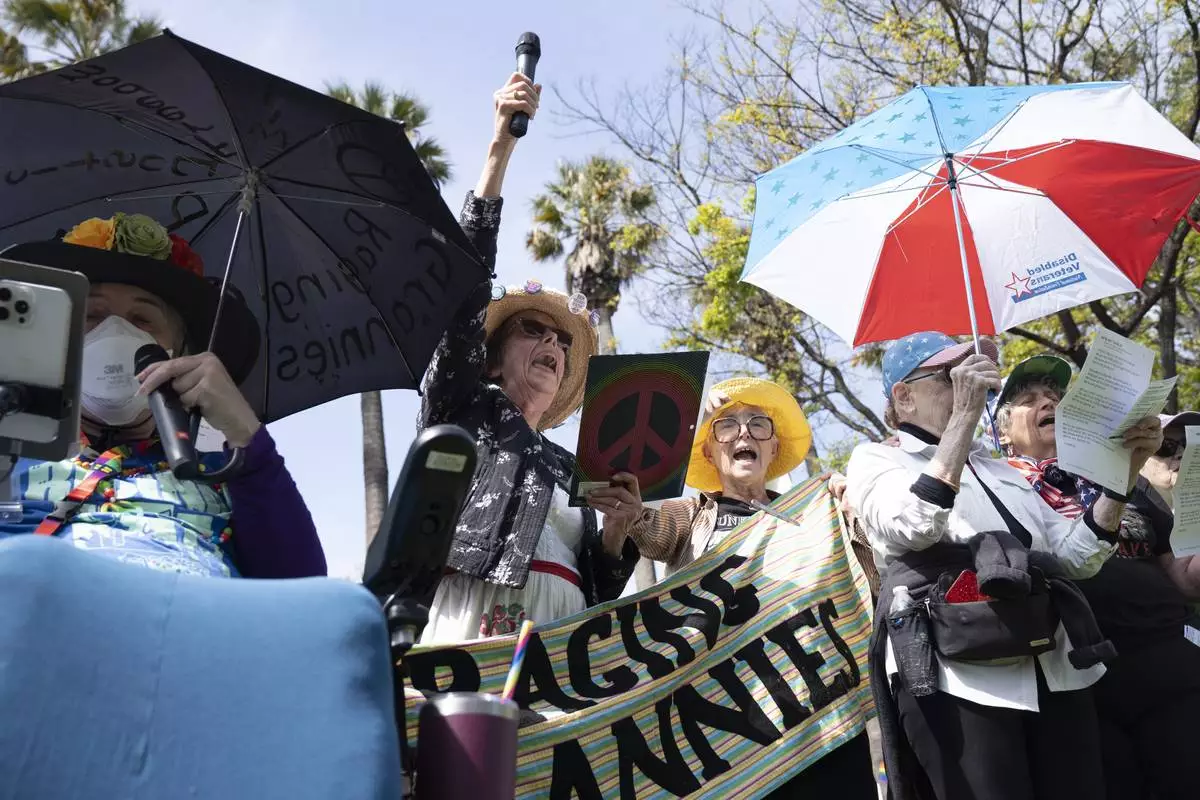
Demonstrators sing a song of protest at a rally against President Donald Trump and Tesla CEO Elon Musk in San Jose, Calif., as part of a national day of action on Saturday, April 5, 2025. (AP Photo/Emily Steinberger)
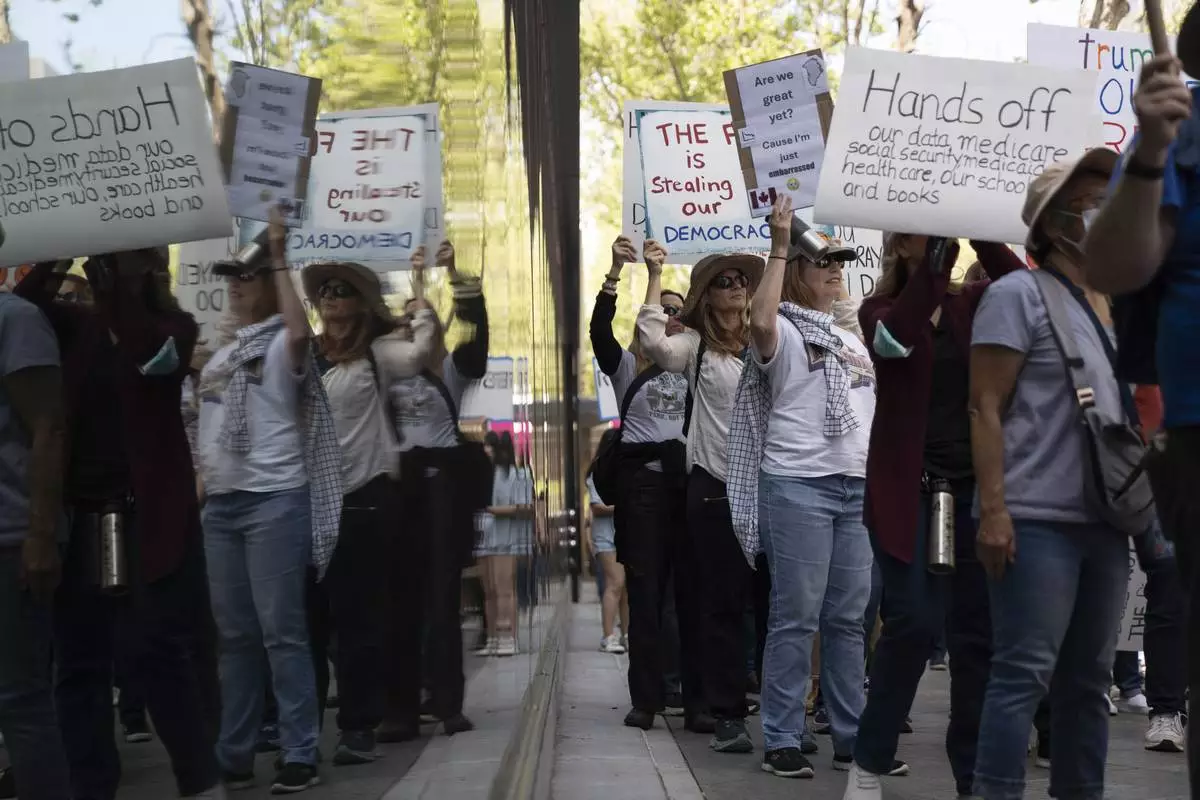
Demonstrators rally against President Donald Trump and Tesla CEO Elon Musk in San Jose, Calif., on Saturday, April 5, 2025, as part of the nationwide "Hands Off!" protest. (AP Photo/Emily Steinberger)
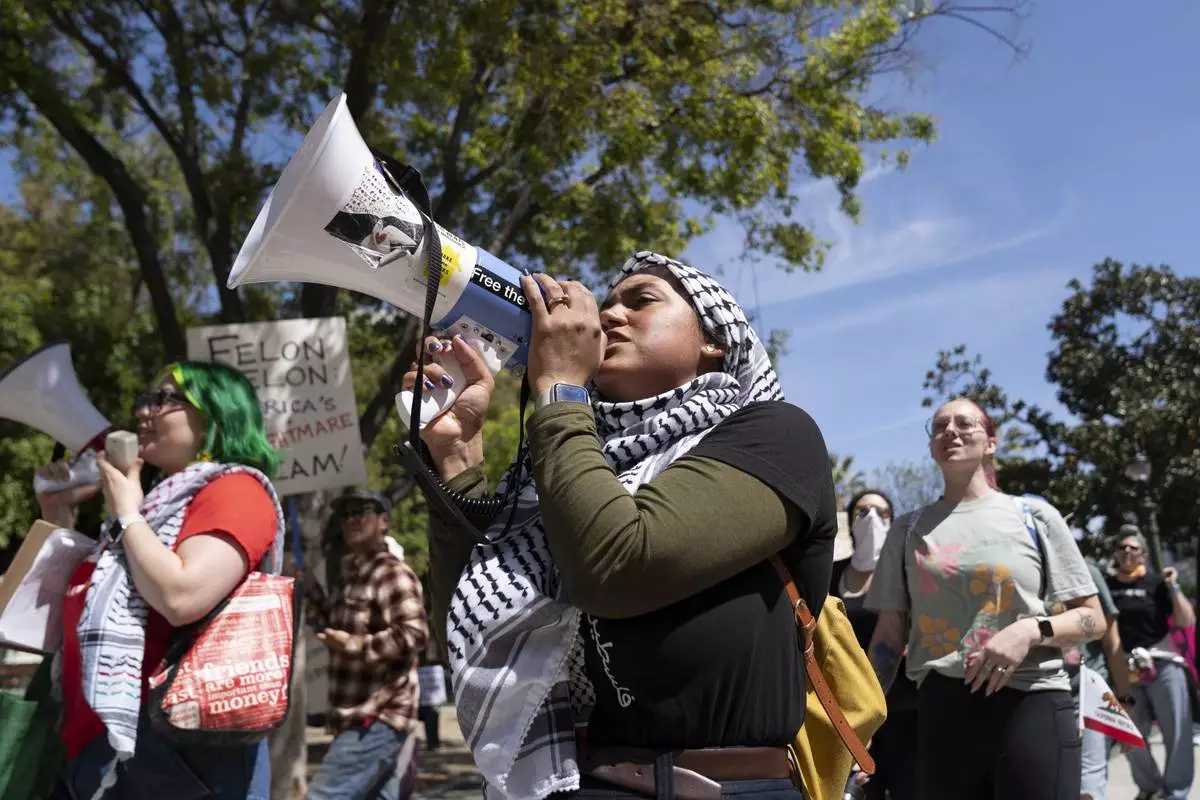
Michelle Parvool chants into a megaphone at a rally against President Donald Trump and Tesla CEO Elon Musk in San Jose, Calif., on Saturday, April 5, 2025, as part of the nationwide "Hands Off!" protest. (AP Photo/Emily Steinberger)
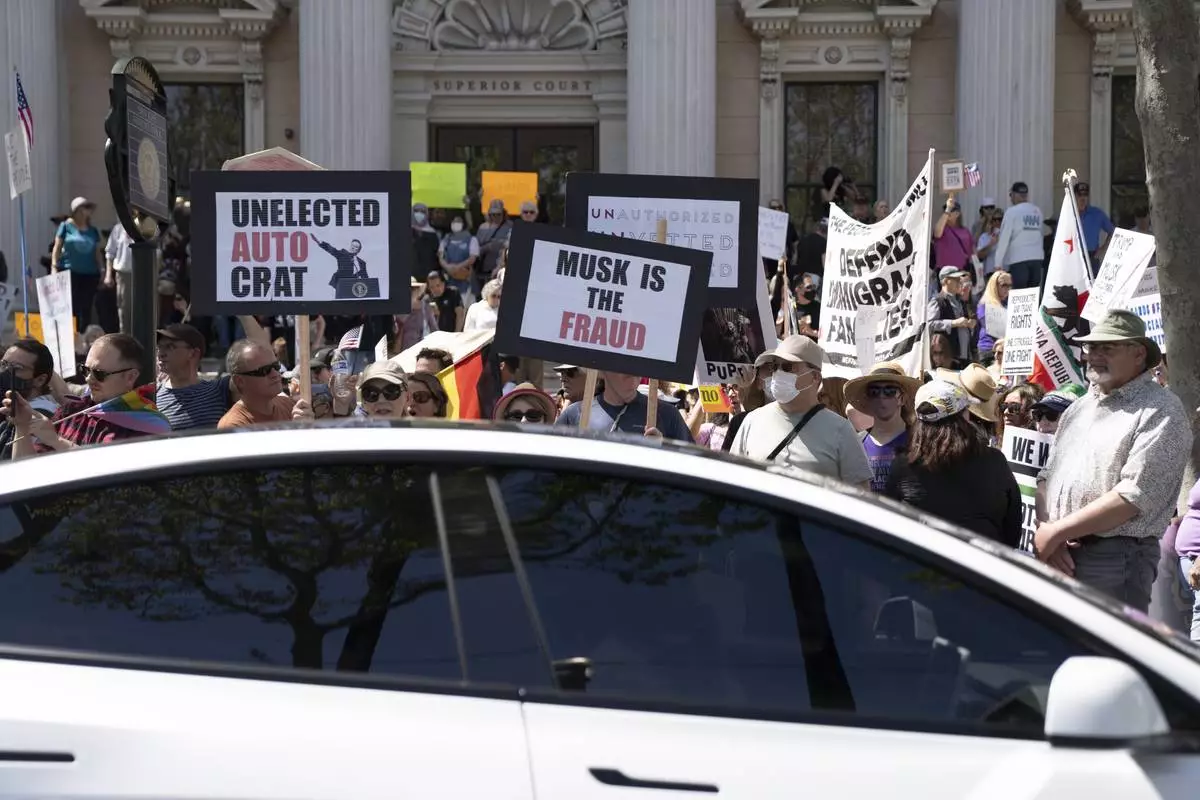
A Tesla vehicle drives past demonstrators during a rally against President Donald Trump and Tesla CEO Elon Musk in San Jose, Calif., on Saturday, April 5, 2025, as part of the nationwide "Hands Off!" protest. (AP Photo/Emily Steinberger)
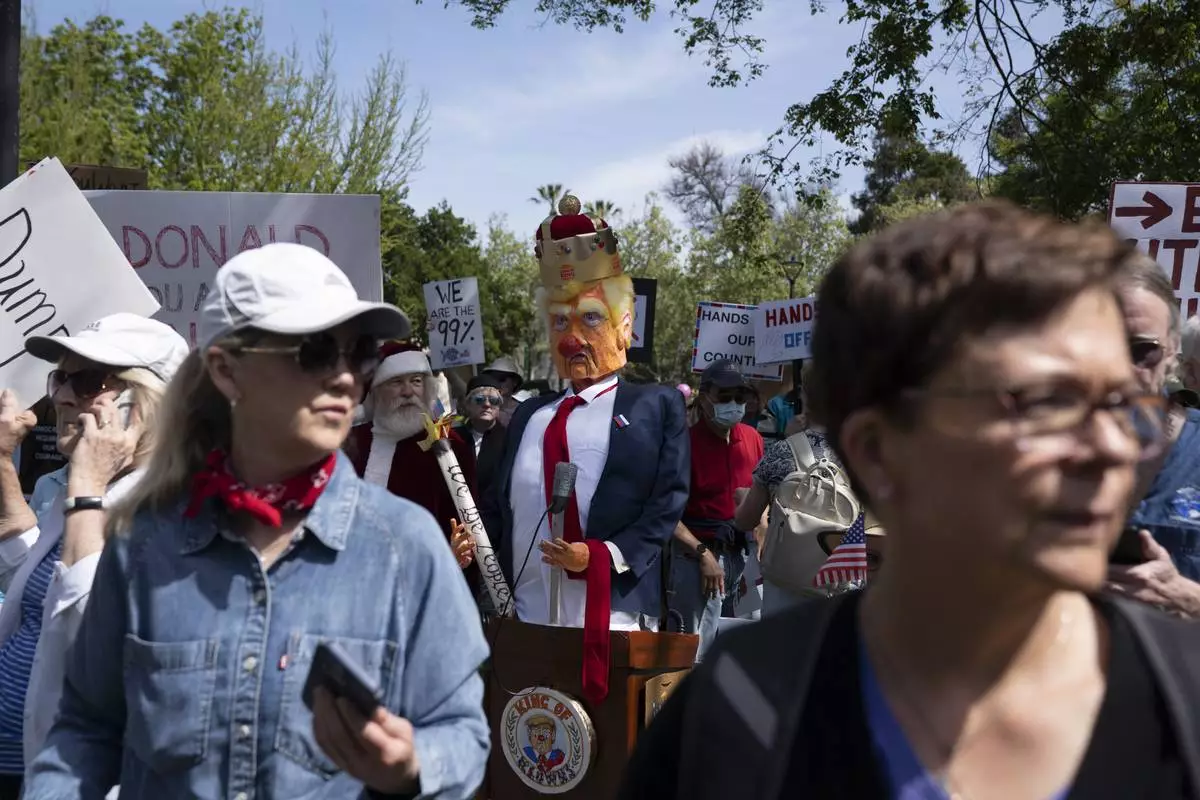
Demonstrators rally against President Donald Trump and Tesla CEO Elon Musk in San Jose, Calif., as part of a national day of action on Saturday, April 5, 2025. (AP Photo/Emily Steinberger)
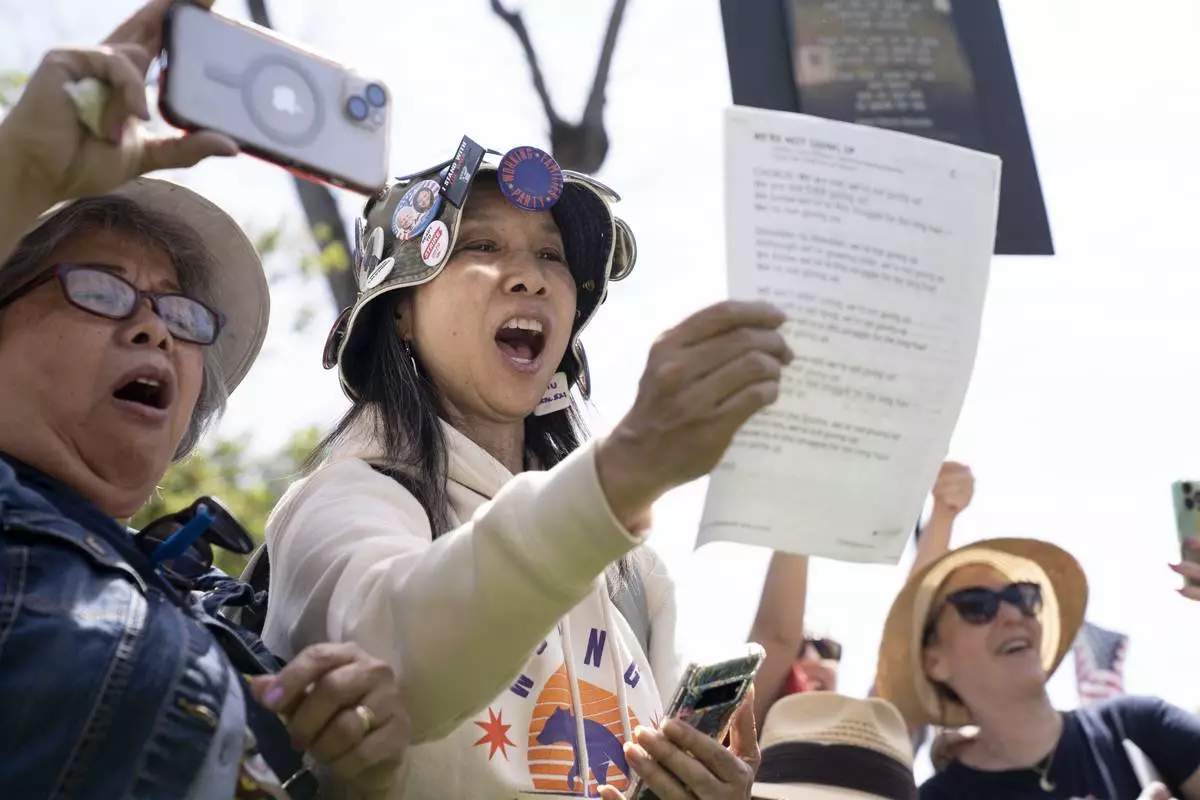
Connie Chew, right, and Aggie Goltiao, left, sing a song of protest at a rally against President Donald Trump and Tesla CEO Elon Musk in San Jose, Calif., as part of a national day of action on Saturday, April 5, 2025. (AP Photo/Emily Steinberger)
Demonstrators rally against President Donald Trump and Tesla CEO Elon Musk in San Jose, Calif., as part of a national day of action on Saturday, April 5, 2025. (AP Photo/Emily Steinberger)












